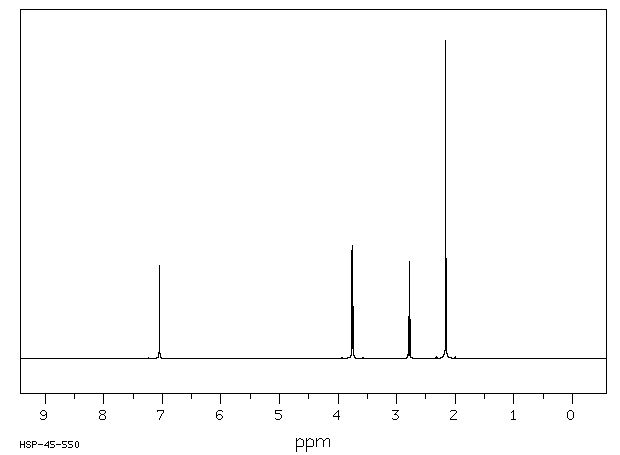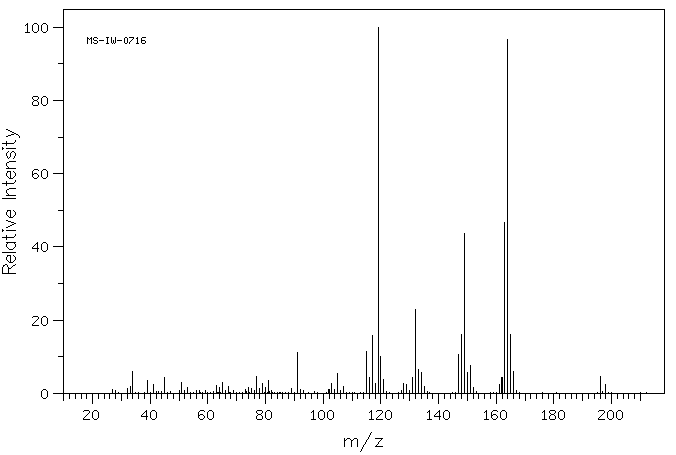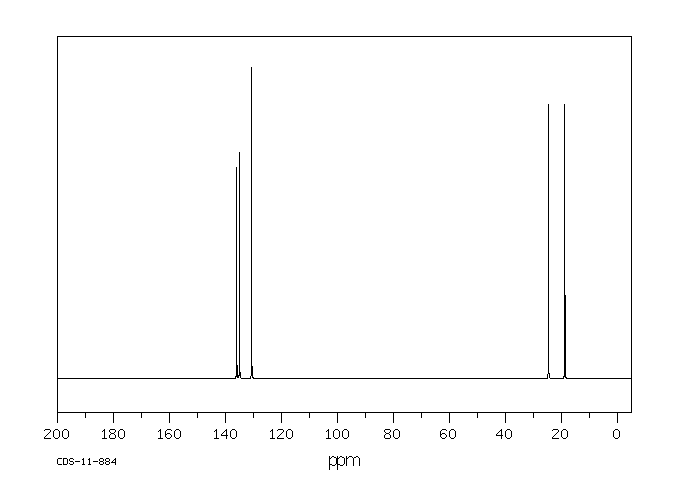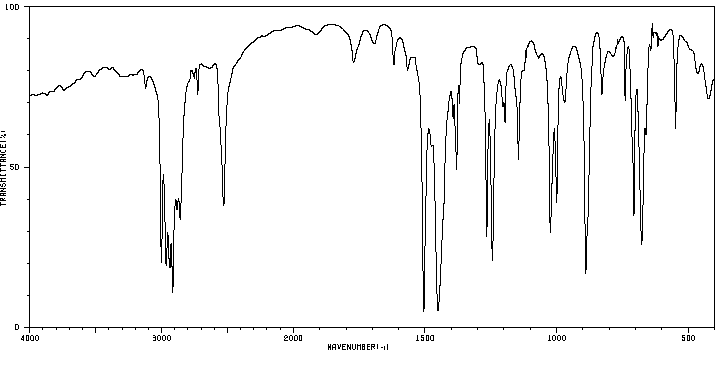杜烯-α1,α2-二硫醇 | 10230-61-2
中文名称
杜烯-α1,α2-二硫醇
中文别名
卢丁二硫醇;杜烯-α,α-二硫醇
英文名称
1,2-dimethyl-4,5-di(mercaptomethyl)benzene
英文别名
1,2-dimethyl-4,5-bis(mercaptomethyl)benzene;1,2-Benzenedimethanethiol, 4,5-dimethyl-;[4,5-dimethyl-2-(sulfanylmethyl)phenyl]methanethiol
CAS
10230-61-2
化学式
C10H14S2
mdl
MFCD00004869
分子量
198.353
InChiKey
NNGQXIUDFKIVKI-UHFFFAOYSA-N
BEILSTEIN
——
EINECS
——
-
物化性质
-
计算性质
-
ADMET
-
安全信息
-
SDS
-
制备方法与用途
-
上下游信息
-
文献信息
-
表征谱图
-
同类化合物
-
相关功能分类
-
相关结构分类
物化性质
-
熔点:64-69 °C
-
沸点:295.69°C (rough estimate)
-
密度:1.1700 (rough estimate)
-
溶解度:溶于氯仿
-
稳定性/保质期:
遵照规格使用和储存则不会分解。
计算性质
-
辛醇/水分配系数(LogP):2.8
-
重原子数:12
-
可旋转键数:2
-
环数:1.0
-
sp3杂化的碳原子比例:0.4
-
拓扑面积:2
-
氢给体数:2
-
氢受体数:2
安全信息
-
安全说明:S24/25
-
海关编码:2930909090
-
储存条件:请将密封于阴凉干燥处。
SDS
1.1 产品标识符
: 杜烯-α1,α2-二硫醇
产品名称
1.2 鉴别的其他方法
4,5-Dimethyl-o-xylene-α,α′-dithiol
1.3 有关的确定了的物质或混合物的用途和建议不适合的用途
仅供科研用途,不作为药物、家庭备用药或其它用途。
模块 2. 危险性概述
2.1 GHS分类
根据化学品全球统一分类与标签制度(GHS)的规定,不是危险物质或混合物。
2.3 其它危害物 - 无
模块 3. 成分/组成信息
3.1 物 质
: 4,5-Dimethyl-o-xylene-α,α′-dithiol
别名
: C10H14S2
分子式
: 198.35 g/mol
分子量
无
模块 4. 急救措施
4.1 必要的急救措施描述
吸入
如果吸入,请将患者移到新鲜空气处。 如果停止了呼吸,给于人工呼吸。
皮肤接触
用肥皂和大量的水冲洗。
眼睛接触
用水冲洗眼睛作为预防措施。
食入
切勿给失去知觉者从嘴里喂食任何东西。 用水漱口。
4.2 主要症状和影响,急性和迟发效应
4.3 及时的医疗处理和所需的特殊处理的说明和指示
无数据资料
模块 5. 消防措施
5.1 灭火介质
灭火方法及灭火剂
用水雾,耐醇泡沫,干粉或二氧化碳灭火。
5.2 源于此物质或混合物的特别的危害
碳氧化物, 硫氧化物
5.3 给消防员的建议
如必要的话,戴自给式呼吸器去救火。
5.4 进一步信息
无数据资料
模块 6. 泄露应急处理
6.1 人员的预防,防护设备和紧急处理程序
防止粉尘的生成。 防止吸入蒸汽、气雾或气体。
6.2 环境保护措施
不要让产物进入下水道。
6.3 抑制和清除溢出物的方法和材料
扫掉和铲掉。 存放进适当的闭口容器中待处理。
6.4 参考其他部分
丢弃处理请参阅第13节。
模块 7. 操作处置与储存
7.1 安全操作的注意事项
在有粉尘生成的地方,提供合适的排风设备。
7.2 安全储存的条件,包括任何不兼容性
贮存在阴凉处。 容器保持紧闭,储存在干燥通风处。
对光和空气敏感
7.3 特定用途
无数据资料
模块 8. 接触控制和个体防护
8.1 容许浓度
最高容许浓度
没有已知的国家规定的暴露极限。
8.2 暴露控制
适当的技术控制
常规的工业卫生操作。
个体防护设备
眼/面保护
请使用经官方标准如NIOSH (美国) 或 EN 166(欧盟) 检测与批准的设备防护眼部。
皮肤保护
戴手套取 手套在使用前必须受检查。
请使用合适的方法脱除手套(不要接触手套外部表面),避免任何皮肤部位接触此产品.
使用后请将被污染过的手套根据相关法律法规和有效的实验室规章程序谨慎处理. 请清洗并吹干双手
所选择的保护手套必须符合EU的89/686/EEC规定和从它衍生出来的EN 376标准。
身体保护
根据危险物质的类型,浓度和量,以及特定的工作场所来选择人体保护措施。,
防护设备的类型必须根据特定工作场所中的危险物的浓度和含量来选择。
呼吸系统防护
不需要保护呼吸。如需防护粉尘损害,请使用N95型(US)或P1型(EN 143)防尘面具。
呼吸器使用经过测试并通过政府标准如NIOSH(US)或CEN(EU)的呼吸器和零件。
模块 9. 理化特性
9.1 基本的理化特性的信息
a) 外观与性状
形状: 固体
b) 气味
无数据资料
c) 气味阈值
无数据资料
d) pH值
无数据资料
e) 熔点/凝固点
熔点/凝固点: 65 - 67 °C - lit.
f) 起始沸点和沸程
无数据资料
g) 闪点
无数据资料
h) 蒸发速率
无数据资料
i) 易燃性(固体,气体)
无数据资料
j) 高的/低的燃烧性或爆炸性限度 无数据资料
k) 蒸汽压
无数据资料
l) 蒸汽密度
无数据资料
m) 相对密度
无数据资料
n) 水溶性
无数据资料
o) n-辛醇/水分配系数
无数据资料
p) 自燃温度
无数据资料
q) 分解温度
无数据资料
r) 粘度
无数据资料
模块 10. 稳定性和反应活性
10.1 反应性
无数据资料
10.2 稳定性
无数据资料
10.3 危险反应的可能性
无数据资料
10.4 应避免的条件
无数据资料
10.5 不兼容的材料
强氧化剂
10.6 危险的分解产物
其它分解产物 - 无数据资料
模块 11. 毒理学资料
11.1 毒理学影响的信息
急性毒性
无数据资料
皮肤刺激或腐蚀
无数据资料
眼睛刺激或腐蚀
无数据资料
呼吸道或皮肤过敏
无数据资料
生殖细胞突变性
无数据资料
致癌性
IARC:
此产品中没有大于或等于 0。1%含量的组分被 IARC鉴别为可能的或肯定的人类致癌物。
生殖毒性
无数据资料
特异性靶器官系统毒性(一次接触)
无数据资料
特异性靶器官系统毒性(反复接触)
无数据资料
吸入危险
无数据资料
潜在的健康影响
吸入 吸入可能有害。 可能引起呼吸道刺激。
摄入 如服入是有害的。
皮肤 如果通过皮肤吸收可能是有害的。 可能引起皮肤刺激。
眼睛 可能引起眼睛刺激。
附加说明
化学物质毒性作用登记: 无数据资料
模块 12. 生态学资料
12.1 生态毒性
无数据资料
12.2 持久存留性和降解性
无数据资料
12.3 潜在的生物蓄积性
无数据资料
12.4 土壤中的迁移性
无数据资料
12.5 PBT 和 vPvB的结果评价
无数据资料
12.6 其它不利的影响
无数据资料
模块 13. 废弃处置
13.1 废物处理方法
产品
将剩余的和未回收的溶液交给处理公司。
受污染的容器和包装
作为未用过的产品弃置。
模块 14. 运输信息
14.1 联合国危险货物编号
欧洲陆运危规: - 国际海运危规: - 国际空运危规: -
14.2 联合国(UN)规定的名称
欧洲陆运危规: 非危险货物
国际海运危规: 非危险货物
国际空运危规: 非危险货物
14.3 运输危险类别
欧洲陆运危规: - 国际海运危规: - 国际空运危规: -
14.4 包裹组
欧洲陆运危规: - 国际海运危规: - 国际空运危规: -
14.5 环境危险
欧洲陆运危规: 否 国际海运危规 海运污染物: 否 国际空运危规: 否
14.6 对使用者的特别提醒
无数据资料
模块 15 - 法规信息
N/A
模块16 - 其他信息
N/A
: 杜烯-α1,α2-二硫醇
产品名称
1.2 鉴别的其他方法
4,5-Dimethyl-o-xylene-α,α′-dithiol
1.3 有关的确定了的物质或混合物的用途和建议不适合的用途
仅供科研用途,不作为药物、家庭备用药或其它用途。
模块 2. 危险性概述
2.1 GHS分类
根据化学品全球统一分类与标签制度(GHS)的规定,不是危险物质或混合物。
2.3 其它危害物 - 无
模块 3. 成分/组成信息
3.1 物 质
: 4,5-Dimethyl-o-xylene-α,α′-dithiol
别名
: C10H14S2
分子式
: 198.35 g/mol
分子量
无
模块 4. 急救措施
4.1 必要的急救措施描述
吸入
如果吸入,请将患者移到新鲜空气处。 如果停止了呼吸,给于人工呼吸。
皮肤接触
用肥皂和大量的水冲洗。
眼睛接触
用水冲洗眼睛作为预防措施。
食入
切勿给失去知觉者从嘴里喂食任何东西。 用水漱口。
4.2 主要症状和影响,急性和迟发效应
4.3 及时的医疗处理和所需的特殊处理的说明和指示
无数据资料
模块 5. 消防措施
5.1 灭火介质
灭火方法及灭火剂
用水雾,耐醇泡沫,干粉或二氧化碳灭火。
5.2 源于此物质或混合物的特别的危害
碳氧化物, 硫氧化物
5.3 给消防员的建议
如必要的话,戴自给式呼吸器去救火。
5.4 进一步信息
无数据资料
模块 6. 泄露应急处理
6.1 人员的预防,防护设备和紧急处理程序
防止粉尘的生成。 防止吸入蒸汽、气雾或气体。
6.2 环境保护措施
不要让产物进入下水道。
6.3 抑制和清除溢出物的方法和材料
扫掉和铲掉。 存放进适当的闭口容器中待处理。
6.4 参考其他部分
丢弃处理请参阅第13节。
模块 7. 操作处置与储存
7.1 安全操作的注意事项
在有粉尘生成的地方,提供合适的排风设备。
7.2 安全储存的条件,包括任何不兼容性
贮存在阴凉处。 容器保持紧闭,储存在干燥通风处。
对光和空气敏感
7.3 特定用途
无数据资料
模块 8. 接触控制和个体防护
8.1 容许浓度
最高容许浓度
没有已知的国家规定的暴露极限。
8.2 暴露控制
适当的技术控制
常规的工业卫生操作。
个体防护设备
眼/面保护
请使用经官方标准如NIOSH (美国) 或 EN 166(欧盟) 检测与批准的设备防护眼部。
皮肤保护
戴手套取 手套在使用前必须受检查。
请使用合适的方法脱除手套(不要接触手套外部表面),避免任何皮肤部位接触此产品.
使用后请将被污染过的手套根据相关法律法规和有效的实验室规章程序谨慎处理. 请清洗并吹干双手
所选择的保护手套必须符合EU的89/686/EEC规定和从它衍生出来的EN 376标准。
身体保护
根据危险物质的类型,浓度和量,以及特定的工作场所来选择人体保护措施。,
防护设备的类型必须根据特定工作场所中的危险物的浓度和含量来选择。
呼吸系统防护
不需要保护呼吸。如需防护粉尘损害,请使用N95型(US)或P1型(EN 143)防尘面具。
呼吸器使用经过测试并通过政府标准如NIOSH(US)或CEN(EU)的呼吸器和零件。
模块 9. 理化特性
9.1 基本的理化特性的信息
a) 外观与性状
形状: 固体
b) 气味
无数据资料
c) 气味阈值
无数据资料
d) pH值
无数据资料
e) 熔点/凝固点
熔点/凝固点: 65 - 67 °C - lit.
f) 起始沸点和沸程
无数据资料
g) 闪点
无数据资料
h) 蒸发速率
无数据资料
i) 易燃性(固体,气体)
无数据资料
j) 高的/低的燃烧性或爆炸性限度 无数据资料
k) 蒸汽压
无数据资料
l) 蒸汽密度
无数据资料
m) 相对密度
无数据资料
n) 水溶性
无数据资料
o) n-辛醇/水分配系数
无数据资料
p) 自燃温度
无数据资料
q) 分解温度
无数据资料
r) 粘度
无数据资料
模块 10. 稳定性和反应活性
10.1 反应性
无数据资料
10.2 稳定性
无数据资料
10.3 危险反应的可能性
无数据资料
10.4 应避免的条件
无数据资料
10.5 不兼容的材料
强氧化剂
10.6 危险的分解产物
其它分解产物 - 无数据资料
模块 11. 毒理学资料
11.1 毒理学影响的信息
急性毒性
无数据资料
皮肤刺激或腐蚀
无数据资料
眼睛刺激或腐蚀
无数据资料
呼吸道或皮肤过敏
无数据资料
生殖细胞突变性
无数据资料
致癌性
IARC:
此产品中没有大于或等于 0。1%含量的组分被 IARC鉴别为可能的或肯定的人类致癌物。
生殖毒性
无数据资料
特异性靶器官系统毒性(一次接触)
无数据资料
特异性靶器官系统毒性(反复接触)
无数据资料
吸入危险
无数据资料
潜在的健康影响
吸入 吸入可能有害。 可能引起呼吸道刺激。
摄入 如服入是有害的。
皮肤 如果通过皮肤吸收可能是有害的。 可能引起皮肤刺激。
眼睛 可能引起眼睛刺激。
附加说明
化学物质毒性作用登记: 无数据资料
模块 12. 生态学资料
12.1 生态毒性
无数据资料
12.2 持久存留性和降解性
无数据资料
12.3 潜在的生物蓄积性
无数据资料
12.4 土壤中的迁移性
无数据资料
12.5 PBT 和 vPvB的结果评价
无数据资料
12.6 其它不利的影响
无数据资料
模块 13. 废弃处置
13.1 废物处理方法
产品
将剩余的和未回收的溶液交给处理公司。
受污染的容器和包装
作为未用过的产品弃置。
模块 14. 运输信息
14.1 联合国危险货物编号
欧洲陆运危规: - 国际海运危规: - 国际空运危规: -
14.2 联合国(UN)规定的名称
欧洲陆运危规: 非危险货物
国际海运危规: 非危险货物
国际空运危规: 非危险货物
14.3 运输危险类别
欧洲陆运危规: - 国际海运危规: - 国际空运危规: -
14.4 包裹组
欧洲陆运危规: - 国际海运危规: - 国际空运危规: -
14.5 环境危险
欧洲陆运危规: 否 国际海运危规 海运污染物: 否 国际空运危规: 否
14.6 对使用者的特别提醒
无数据资料
模块 15 - 法规信息
N/A
模块16 - 其他信息
N/A
反应信息
-
作为反应物:描述:参考文献:名称:硫醇-二硫化物交换的结构-反应性关系摘要:平衡常数由 36 个二硫醇和三硫醇与衍生自 2-巯基乙醇或二硫苏糖醇的二硫化物之间的硫醇-二硫化物交换确定。反应在甲醇-d/水性缓冲液 (pH 7) 或甲醇中进行,在 25°C 下,使用 NMR 光谱跟踪反应。这些数据用于根据还原电位对二硫醇进行排序并推断其结构氧化时由它们形成的二硫化物。二硫醇的还原能力与氧化时形成的含二硫化物环的大小之间存在普遍的相关性:形成六元环的二硫醇还原性最强(K = 103-105 M 相对于氧化的 2-巯基乙醇);五元和七元环的还原性降低约 1 个数量级。类似于 1 的化合物,2-乙二硫醇在相对稀释的溶液 (- 1 mM) 中形成环状双(二硫化物)二聚体,但在较高浓度下聚合。其他类别的二硫醇在氧化时形成聚合物。DOI:10.1021/ja00256a040
-
作为产物:描述:参考文献:名称:硫醇-二硫化物交换的结构-反应性关系摘要:平衡常数由 36 个二硫醇和三硫醇与衍生自 2-巯基乙醇或二硫苏糖醇的二硫化物之间的硫醇-二硫化物交换确定。反应在甲醇-d/水性缓冲液 (pH 7) 或甲醇中进行,在 25°C 下,使用 NMR 光谱跟踪反应。这些数据用于根据还原电位对二硫醇进行排序并推断其结构氧化时由它们形成的二硫化物。二硫醇的还原能力与氧化时形成的含二硫化物环的大小之间存在普遍的相关性:形成六元环的二硫醇还原性最强(K = 103-105 M 相对于氧化的 2-巯基乙醇);五元和七元环的还原性降低约 1 个数量级。类似于 1 的化合物,2-乙二硫醇在相对稀释的溶液 (- 1 mM) 中形成环状双(二硫化物)二聚体,但在较高浓度下聚合。其他类别的二硫醇在氧化时形成聚合物。DOI:10.1021/ja00256a040
文献信息
-
A new synthesis of 3-deoxy-d--2-octulosonic acid (kdo) from d-mannose作者:Masahiro Imoto、Shoichi Kusomoto、Tetsu ShibaDOI:10.1016/s0040-4039(00)61856-7日期:1987.1A new efficient chemical synthesis of KDO (1) with the natural configuration was achieved via the condensation of a protected D-mannitol triflate (3) with methyl glyoxylate dithioacetal (2) as a key step.
-
Bis-thiolurethane aus Isocyanaten und substituierten Alkan- sowie Benzoldithiolen
-
[EN] NOVEL PRODRUGS OF DITHIOL MUCOLYTIC AGENTS<br/>[FR] NOUVEAUX PROMÉDICAMENTS D'AGENTS MUCOLYTIQUES À BASE DE DITHIOL申请人:PARION SCIENCES INC公开号:WO2016176423A1公开(公告)日:2016-11-03Provided are mucolytic compounds that are more effective, and/or absorbed less rapidly from mucosal surfaces, and/or are better tolerated as compared to N-acetylcysteine (NAC) and DTT. The compounds are represented by compounds of Formula I which embrace structures (la)-(Ib), where the structural variables are as defined herein.
-
Reaktionen von Triethylammonium-1-(2-chlor-1,3-dioxo-2-indanyl)-chlormethansulfonat und -dichlormethansulfonat mit OH-, SH- und NH-Nucleophilen作者:Wolfgang Hanefeld、Bernd SpangenbergDOI:10.1002/ardp.19883210503日期:——Triethylammonium‐1‐(2‐chlor‐1,3‐dioxo‐2‐indanyl)‐chlormethansulfonat (1b) und ‐dichlormethansulfonat (1a) wurden mit monofunktionellen, offenkettigen und cyclischen bifunktionellen Nucleophilen in einer neuartigen Reaktion zu den Bisacyl‐ketenacetal‐ bzw. Aminalstrukturen 2 und 5 bis 8 bzw. den Enaminoketon‐strukturen 4 umgesetzt.
-
Heterolytic H2 activation by rhodium thiolato complexes bearing the hydrotris(pyrazolyl)borato ligand and application to catalytic hydrogenation under mild conditions作者:Hidetake Seino、Yoshiyuki Misumi、Yoshihiro Hojo、Yasushi MizobeDOI:10.1039/b923557d日期:——Thiolato complexes of Rh(III) bearing a hydrotris(3,5-dimethylpyrazolyl)borato ligand (TpMe2) have been prepared, and their reactivity toward H2 has been investigated. The bis(thiolato) complex [TpMe2Rh(SPh)2(MeCN)] (1) reacted with 1 atm H2 at 20 °C to produce the hydrido-thiolato complex [TpMe2RhH(SPh)(MeCN)] (2) and PhSH via heterolytic cleavage of H2. This process is reversible and in equilibrium in THF and benzene. The bis(selenolato) complex [TpMe2Rh(SePh)2(MeCN)] (4) was also converted to [TpMe2RhH(SePh)(MeCN)] and PhSeH under 1 atm H2, but the equilibrium largely shifted to 4. Reaction of the dithiolato complex [TpMe2Rh(bdt)(MeCN)] (3; bdt = 1,2-C6H4S2) with H2 occurred in the presence of amine, giving the anionic hydrido complex [TpMe2RhH(bdt)]− and an equimolar amount of ammonium cations. Catalytic activity for hydrogenation has been examined under 1 atm H2 at 20–50 °C. While 1, 2, and 4 slowly hydrogenated styrene at similar rates at 50 °C, activities for the hydrogenation of N-benzylideneaniline increased in the order, 2 < 1 < 4. Complex 3 was found to be the most active and selective catalyst for hydrogenation of imines, and thus a variety of imines were reduced at 20 °C under 1 atm H2, with the CC and CO bonds in the substrate molecules completely preserved. An ionic mechanism was involved to explain such high chemoselectivity.已经制备了含有氢三(3,5-二甲基吡唑基)硼酸盐配体(TpMe2)的Rh(III)硫醇配合物,并研究了其对H2的反应性。双(硫醇)配合物[TpMe2Rh(SPh)2(MeCN)](1)在20°C下与1 atm H2反应,生成氢化硫醇配合物[TpMe2RhH(SPh)(MeCN)](2)和PhSH,这个过程通过H2的异裂反应发生。该过程在THF和苯中是可逆的并处于平衡状态。双(硒醇)配合物[TpMe2Rh(SePh)2(MeCN)](4)在1 atm H2下也转化为[TpMe2RhH(SePh)(MeCN)]和PhSeH,但平衡大多偏向于4。在胺的存在下,二硫醇配合物[TpMe2Rh(bdt)(MeCN)](3;bdt = 1,2-C6H4S2)与H2反应,生成阴离子氢化配合物[TpMe2RhH(bdt)]−和等摩尔的铵阳离子。在1 atm H2和20-50°C下,氢化的催化活性进行了研究。虽然1、2和4在50°C下以相似的速率缓慢氢化苯乙烯,但对N-苄亚胺的氢化活性呈现出2 < 1 < 4的顺序。配合物3被发现是氢化亚胺的最活跃和选择性的催化剂,因此在20°C和1 atm H2下对多种亚胺进行了还原,底物分子中的C-C和C-O键完全保留。高选择性的化学选择性解释采用了离子机制。
表征谱图
-
氢谱1HNMR
-
质谱MS
-
碳谱13CNMR
-
红外IR
-
拉曼Raman
-
峰位数据
-
峰位匹配
-
表征信息
同类化合物
(βS)-β-氨基-4-(4-羟基苯氧基)-3,5-二碘苯甲丙醇
(S,S)-邻甲苯基-DIPAMP
(S)-(-)-7'-〔4(S)-(苄基)恶唑-2-基]-7-二(3,5-二-叔丁基苯基)膦基-2,2',3,3'-四氢-1,1-螺二氢茚
(S)-盐酸沙丁胺醇
(S)-3-(叔丁基)-4-(2,6-二甲氧基苯基)-2,3-二氢苯并[d][1,3]氧磷杂环戊二烯
(S)-2,2'-双[双(3,5-三氟甲基苯基)膦基]-4,4',6,6'-四甲氧基联苯
(S)-1-[3,5-双(三氟甲基)苯基]-3-[1-(二甲基氨基)-3-甲基丁烷-2-基]硫脲
(R)富马酸托特罗定
(R)-(-)-盐酸尼古地平
(R)-(-)-4,12-双(二苯基膦基)[2.2]对环芳烷(1,5环辛二烯)铑(I)四氟硼酸盐
(R)-(+)-7-双(3,5-二叔丁基苯基)膦基7''-[((6-甲基吡啶-2-基甲基)氨基]-2,2'',3,3''-四氢-1,1''-螺双茚满
(R)-(+)-7-双(3,5-二叔丁基苯基)膦基7''-[(4-叔丁基吡啶-2-基甲基)氨基]-2,2'',3,3''-四氢-1,1''-螺双茚满
(R)-(+)-7-双(3,5-二叔丁基苯基)膦基7''-[(3-甲基吡啶-2-基甲基)氨基]-2,2'',3,3''-四氢-1,1''-螺双茚满
(R)-(+)-4,7-双(3,5-二-叔丁基苯基)膦基-7“-[(吡啶-2-基甲基)氨基]-2,2”,3,3'-四氢1,1'-螺二茚满
(R)-3-(叔丁基)-4-(2,6-二苯氧基苯基)-2,3-二氢苯并[d][1,3]氧杂磷杂环戊烯
(R)-2-[((二苯基膦基)甲基]吡咯烷
(R)-1-[3,5-双(三氟甲基)苯基]-3-[1-(二甲基氨基)-3-甲基丁烷-2-基]硫脲
(N-(4-甲氧基苯基)-N-甲基-3-(1-哌啶基)丙-2-烯酰胺)
(5-溴-2-羟基苯基)-4-氯苯甲酮
(5-溴-2-氯苯基)(4-羟基苯基)甲酮
(5-氧代-3-苯基-2,5-二氢-1,2,3,4-oxatriazol-3-鎓)
(4S,5R)-4-甲基-5-苯基-1,2,3-氧代噻唑烷-2,2-二氧化物-3-羧酸叔丁酯
(4S,4''S)-2,2''-亚环戊基双[4,5-二氢-4-(苯甲基)恶唑]
(4-溴苯基)-[2-氟-4-[6-[甲基(丙-2-烯基)氨基]己氧基]苯基]甲酮
(4-丁氧基苯甲基)三苯基溴化磷
(3aR,8aR)-(-)-4,4,8,8-四(3,5-二甲基苯基)四氢-2,2-二甲基-6-苯基-1,3-二氧戊环[4,5-e]二恶唑磷
(3aR,6aS)-5-氧代六氢环戊基[c]吡咯-2(1H)-羧酸酯
(2Z)-3-[[(4-氯苯基)氨基]-2-氰基丙烯酸乙酯
(2S,3S,5S)-5-(叔丁氧基甲酰氨基)-2-(N-5-噻唑基-甲氧羰基)氨基-1,6-二苯基-3-羟基己烷
(2S,2''S,3S,3''S)-3,3''-二叔丁基-4,4''-双(2,6-二甲氧基苯基)-2,2'',3,3''-四氢-2,2''-联苯并[d][1,3]氧杂磷杂戊环
(2S)-(-)-2-{[[[[3,5-双(氟代甲基)苯基]氨基]硫代甲基]氨基}-N-(二苯基甲基)-N,3,3-三甲基丁酰胺
(2S)-2-[[[[[((1S,2S)-2-氨基环己基]氨基]硫代甲基]氨基]-N-(二苯甲基)-N,3,3-三甲基丁酰胺
(2S)-2-[[[[[[((1R,2R)-2-氨基环己基]氨基]硫代甲基]氨基]-N-(二苯甲基)-N,3,3-三甲基丁酰胺
(2-硝基苯基)磷酸三酰胺
(2,6-二氯苯基)乙酰氯
(2,3-二甲氧基-5-甲基苯基)硼酸
(1S,2S,3S,5S)-5-叠氮基-3-(苯基甲氧基)-2-[(苯基甲氧基)甲基]环戊醇
(1S,2S,3R,5R)-2-(苄氧基)甲基-6-氧杂双环[3.1.0]己-3-醇
(1-(4-氟苯基)环丙基)甲胺盐酸盐
(1-(3-溴苯基)环丁基)甲胺盐酸盐
(1-(2-氯苯基)环丁基)甲胺盐酸盐
(1-(2-氟苯基)环丙基)甲胺盐酸盐
(1-(2,6-二氟苯基)环丙基)甲胺盐酸盐
(-)-去甲基西布曲明
龙蒿油
龙胆酸钠
龙胆酸叔丁酯
龙胆酸
龙胆紫-d6
龙胆紫










